番茄(Lycopersicon esculentum Mill)是全球种植最广泛的园艺作物之一。 在过去40 a中,全球番茄(新鲜和加工)的年产量增加了约300%[1]。 2017年,全球番茄产量约为1.6亿t。美国、中国、欧盟、土耳其和印度是西红柿的主要生产国。番茄是典型的喜温蔬菜,温度和光照是番茄进行生长发育和光合作用的必要条件[2]。目前,关于昼夜温差对设施番茄叶片光合特性和叶绿素荧光参数的影响研究较多[3-6],但各环境因子之间是相互影响,相互制约的[7-11],孤立的研究某一因子对番茄产量和品质的影响不能很好地反映客观规律。赵玉萍等[12]研究表明,番茄短期处于亚高温处理下,植株生长加快,但长期处于亚高温处理下,会出现早衰现象。程智慧等[13]研究了设施番茄果实生长与环境因子的关系,划出了果实生长速率较快的环境因子范围,但没有研究环境因子与番茄产量及品质的关系。王强等[14]研究了不同天气条件下温室番茄栽培环境因子的变化特征,但没有深入研究环境因子对番茄生长发育的影响。
定植日期显著影响日光温室番茄的生产水平。最佳定植日期是在最有利于番茄幼苗生长的环境条件下定植,并且营养生长期的环境条件能使番茄产量最大化。近年来国内外关于不同播期对玉米、小麦、和马铃薯研究很多[15-19],但关于不同定植期对日光温室番茄的影响却鲜有报道。 国外专家指出,种植日期的选择必须确保热环境有利于作物的建立和完成其生命周期,而不降低产量[20]。但很少有人研究环境因子与番茄产量之间的关系。因此,本研究从2017年2月27开始,到2018年1月27日, 每月定植一茬,通过各生育期的环境因子与产量的相关性分析,确定番茄产量变化的关键环境因子;通过每茬试验的生育期及产量的对比,确定宁夏温室番茄的最佳定植日期。
1 材料和方法
1.1 试验地概况
试验于2017-2018年在宁夏园艺产业园科研开发区日光温室进行,供试温室长80 m,跨度7 m。宁夏园艺产业园位于宁夏回族自治区银川市贺兰县, 地处38°26′~38°48′N,105°53′~106°36′E,属温带大陆性气候。年平均气温9.7 ℃,极端最高气温36.9 ℃,极端最低气温-24 ℃,平均昼夜温差13.4 ℃,且≥10 ℃的积温为3 281.6 ℃。
1.2 试验设计
从2017年2月27日-2018年1月27日,每月定植一茬,以定植日期为处理 ,共12个处理,4次重复。番茄品种为粉晏1号,每公顷定植30 000株,行距为0.75 m,株距为0.45 m。定植前施入有机肥,缓苗后,采用水肥一体化,浇灌营养液。所有处理统一管理,进行杂草病虫害防控管理。
1.3 测定项目
按常规方法记载每个处理的定植期(PLD)、开花期(BLD)、采收期(HAD)和拉秧期(UPD),各个时期的环境因子(平均气温、平均最高气温、平均最低气温、白天平均气温、夜晚平均气温、平均昼夜温差、平均相对空气湿度、平均光照强度、平均土壤温度和有效积温)以及各生育期天数和成熟后各处理的单果质量、单株结果数和产量。大棚的环境因子用紫藤连线(北京紫藤连线科技有限公司,型号为ZWSN-C-A)采集,测点安置在温室东20 m、中、西20 m 3点,且距地面1.5 m高,每10 min记录一次。
一般来说,有效积温(GDD)是用于分析作物生长需要的热量的指标。在本研究中,GDD是指日平均温度高于10 ℃且低于30 ℃的积温。
其中,Tmax和Tmin 分别指最高气温和最低温度气温,Tbase 和Tcutoff分别是10,30 ℃。
1.4 数据处理
首先对不同处理条件下的番茄生育期、单果质量、单株结果数和产量分别进行方差分析,然后以平均数为基础进行番茄定植-开花期、开花-采收期、采收-拉秧期及全生育期的环境因子与番茄产量和生育期的相关性分析,确定影响番茄产量和生育期的关键环境因子,以RStudio数据处理系统和Origin 9.1操作系统分析试验数据。
2 结果与分析
2.1 不同处理番茄各生育期的主要环境因子情况
如表1可知,2017年6月27日和2017年7月27日定植,定植-开花期的平均气温、平均最高气温、平均最低气温、白天平均气温和夜晚平均气温都高于其他处理,且平均最高气温和白天平均气温都高于30 ℃,不利于番茄的生长发育。2017年11月27日、2017年12月27日和2018年1月27日定植,定植-开花期的平均相对湿度均高于其他处理,分别为77.29%,76.06%,72.78%。2017年4月27日、2017年5月27日和2017年6月27日定植,开花-采收期的平均气温、平均最低气温、白天平均气温和夜间晚平均气温均高于其他处理。2017年7月27日定植,采收-拉秧期的平均气温、平均最高气温和平均最低气温均低于其他处理,分别为13.02,26.60,6.94 ℃。而2017年2月27日和2017年3月27日定植,采收-拉秧期的平均气温、平均最高气温、平均最低气温、白天平均气温、夜晚平均气温和平均土壤温度均高于其他处理。
表1 不同处理番茄各生育期的主要环境因子
Tab.1 Environment factor values in different growth stages with different treatment

生育期Growthperiod定植期Plantingdates平均气温/℃Meantemperature平均最高气温/℃Meanmaximum temperature平均最低气温/℃Meanminimumtemperature白天平均气温/℃Daytimemeantemperature夜晚平均气温/℃Meantemperatureat night昼夜温差/℃Meantemperaturedifference平均相对湿度/%Meanrelativehumidity平均光照强度/lx Mean lightintensity平均土壤温度/℃Mean soiltemper-ature有效积温/℃GDD定植-开花期2017-02-2718.3631.6212.4821.3814.826.5649.976 310.0020.57345.75Planting dates-2017-03-2721.5532.8715.4824.9417.707.2446.4910 330.0024.55366.24Blossoming dates2017-04-2723.2636.1114.6228.5617.1411.4343.3810 760.0026.68355.042017-05-2725.6338.6416.7431.1019.5311.5749.369 930.0027.96401.622017-06-2727.4138.8218.5632.5421.4011.1457.217 990.0028.32371.392017-07-2727.0039.3318.3731.9721.5410.4360.299 990.0029.48438.772017-08-2722.3534.7214.6527.1917.459.7460.047 380.0024.01409.432017-09-2719.9631.0414.1023.5316.477.0666.085 610.0021.74354.392017-10-2719.3228.8014.6622.1316.465.6769.004 710.0020.92273.292017-11-2712.4525.756.7415.338.446.8977.293 190.0013.92289.972017-12-2712.9526.856.3716.318.667.6576.063 660.0015.19326.392018-01-2714.2228.757.0518.279.908.3772.784 700.0016.30229.68开花-采收期2017-02-2721.9434.4114.6326.3317.189.1545.9010 570.0025.15794.66Blossoming dates-2017-03-2724.1737.1315.3429.6418.1111.5346.0710 640.0027.26887.13Harvesting dates2017-04-2725.3638.3916.3430.9819.3411.6450.609 540.0027.72718.022017-05-2727.2238.6418.9132.2422.0010.2458.178 170.0028.66658.792017-06-2725.8537.0918.2130.2821.109.1861.768 240.0028.14884.772017-07-2722.1433.6714.8526.5217.558.9762.566 980.0024.59713.842017-08-2720.0131.2114.3622.9216.426.5064.185 800.0021.81715.94
表1(续)
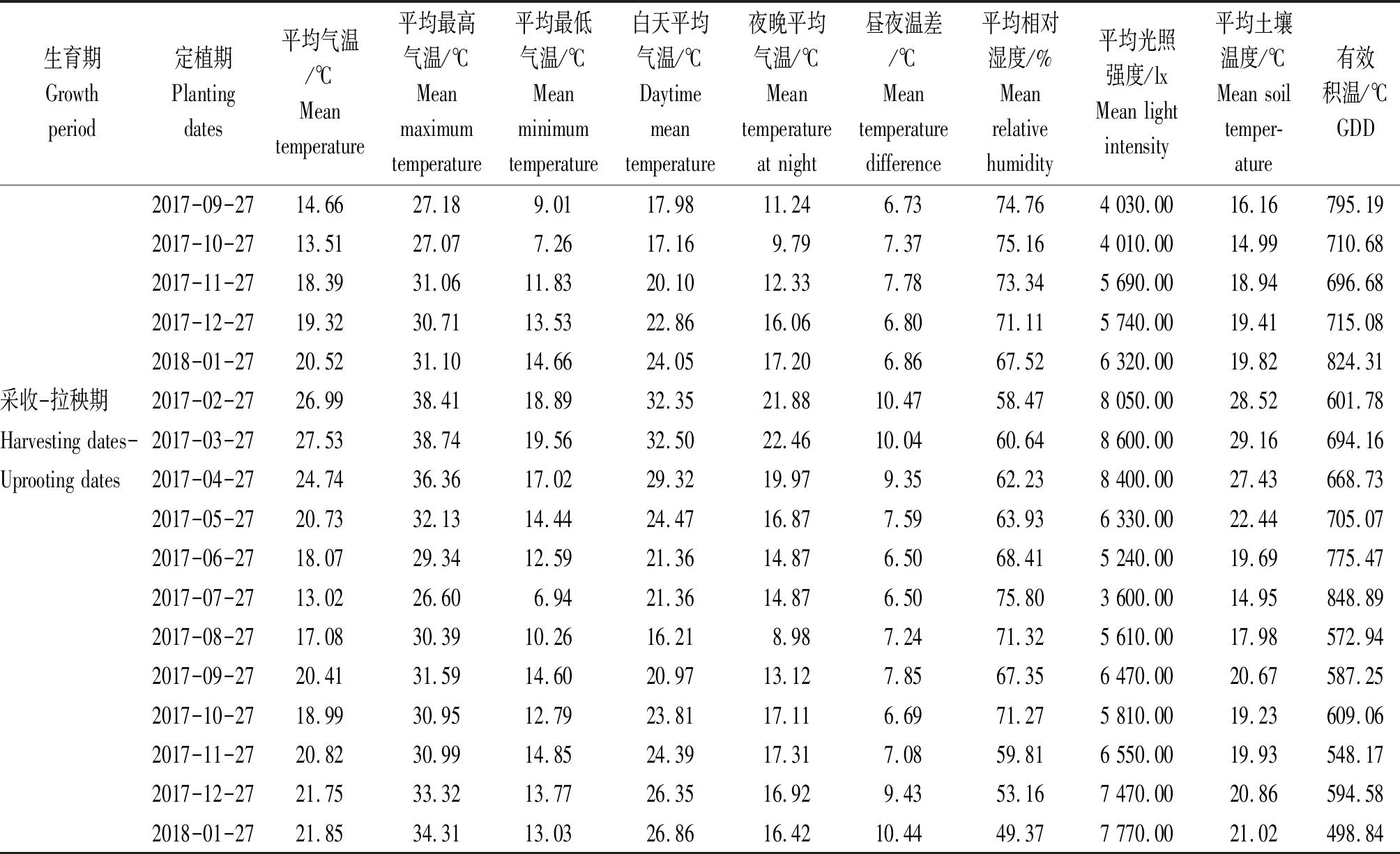
生育期Growthperiod定植期Plantingdates平均气温/℃Meantemperature平均最高气温/℃Meanmaximum temperature平均最低气温/℃Meanminimumtemperature白天平均气温/℃Daytimemeantemperature夜晚平均气温/℃Meantemperatureat night昼夜温差/℃Meantemperaturedifference平均相对湿度/%Meanrelativehumidity平均光照强度/lx Mean lightintensity平均土壤温度/℃Mean soiltemper-ature有效积温/℃GDD2017-09-2714.6627.189.0117.9811.246.7374.764 030.0016.16795.192017-10-2713.5127.077.2617.169.797.3775.164 010.0014.99710.682017-11-2718.3931.0611.8320.1012.337.7873.345 690.0018.94696.682017-12-2719.3230.7113.5322.8616.066.8071.115 740.0019.41715.082018-01-2720.5231.1014.6624.0517.206.8667.526 320.0019.82824.31采收-拉秧期2017-02-2726.9938.4118.8932.3521.8810.4758.478 050.0028.52601.78Harvesting dates-2017-03-2727.5338.7419.5632.5022.4610.0460.648 600.0029.16694.16Uprooting dates2017-04-2724.7436.3617.0229.3219.979.3562.238 400.0027.43668.732017-05-2720.7332.1314.4424.4716.877.5963.936 330.0022.44705.072017-06-2718.0729.3412.5921.3614.876.5068.415 240.0019.69775.472017-07-2713.0226.606.9421.3614.876.5075.803 600.0014.95848.892017-08-2717.0830.3910.2616.218.987.2471.325 610.0017.98572.942017-09-2720.4131.5914.6020.9713.127.8567.356 470.0020.67587.252017-10-2718.9930.9512.7923.8117.116.6971.275 810.0019.23609.062017-11-2720.8230.9914.8524.3917.317.0859.816 550.0019.93548.172017-12-2721.7533.3213.7726.3516.929.4353.167 470.0020.86594.582018-01-2721.8534.3113.0326.8616.4210.4449.377 770.0021.02498.84
2.2 不同处理对番茄生育期的影响
表2是不同定植期番茄生育期的比较,将番茄的生育期分为3个阶段:定植-开花期、开花-采收期和采收-拉秧期。由表2可知,2017年4月27日和2017年5月27日定植的番茄全生育期最短,均为105 d,且比2017年9月27日定植的番茄全生育期缩短了41.67%。2017年6月27日和 2017年7月27日定植的番茄定植-开花期最短,分别为14,16 d。而2017年9月27日和2017年10月27日定植的番茄开花-采收期最长,分别为95,87 d。2017年2月27日和2018年1月27日定植的番茄始采收期-拉秧期最短,分别为37,34 d。
表2 不同处理番茄生育期
Tab.2 Tomato growth period in different treatment
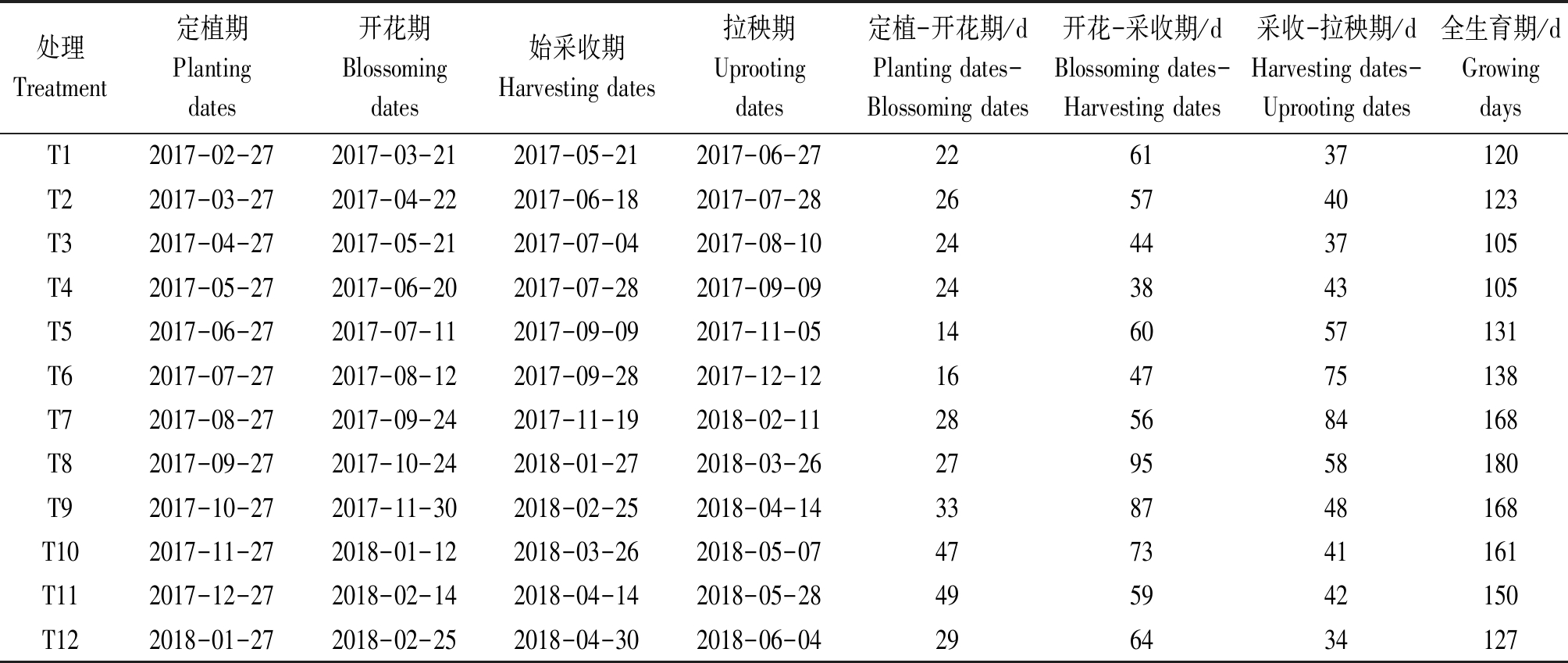
处理Treatment定植期Planting dates开花期Blossoming dates始采收期Harvesting dates拉秧期Uprooting dates定植-开花期/dPlanting dates-Blossoming dates开花-采收期/dBlossoming dates-Harvesting dates采收-拉秧期/dHarvesting dates-Uprooting dates全生育期/dGrowing daysT12017-02-272017-03-212017-05-212017-06-27226137120T22017-03-272017-04-222017-06-182017-07-28265740123T32017-04-272017-05-212017-07-042017-08-10244437105T42017-05-272017-06-202017-07-282017-09-09243843105T52017-06-272017-07-112017-09-092017-11-05146057131T62017-07-272017-08-122017-09-282017-12-12164775138T72017-08-272017-09-242017-11-192018-02-11285684168T82017-09-272017-10-242018-01-272018-03-26279558180T92017-10-272017-11-302018-02-252018-04-14338748168T102017-11-272018-01-122018-03-262018-05-07477341161T112017-12-272018-02-142018-04-142018-05-28495942150T122018-01-272018-02-252018-04-302018-06-04296434127
2.3 不同处理番茄生育期与环境因子的相关性分析
将环境因子与番茄生育期的相关系数进行比较,相关系数越大,说明该因子对番茄生育期的影响越显著,则该因子就是影响番茄生育期的关键因子。生育期的环境因子与生育期长度有显著的相关性。平均最高气温、平均最低气温和平均气温均与生育期长度呈极显著负相关,且相关系数分别为0.87,0.84,0.87(图1-A)。白天平均气温、夜晚平均气温和平均昼夜温差与生育期长度呈极显著负相关,相关系数分别为0.88,0.85,0.82(图1-B)。平均土壤温度与生育期长度呈极显著负相关,相关系数为0.80(图1-D)。平均光照强度与生育期长度呈极显著负相关,相关系数为0.78(图1-F)。而平均相对湿度与生育期长度呈极显著正相关,且相关系数为0.68(图1-C)。GDD与番茄生育期长度无显著相关性(图1-E)。因此,平均最高气温、平均最低气温、平均气温、白天平均气温、夜晚平均气温、平均昼夜温差、平均土壤温度、平均光照强度和平均相对湿度均是影响番茄生育期的关键环境因子。
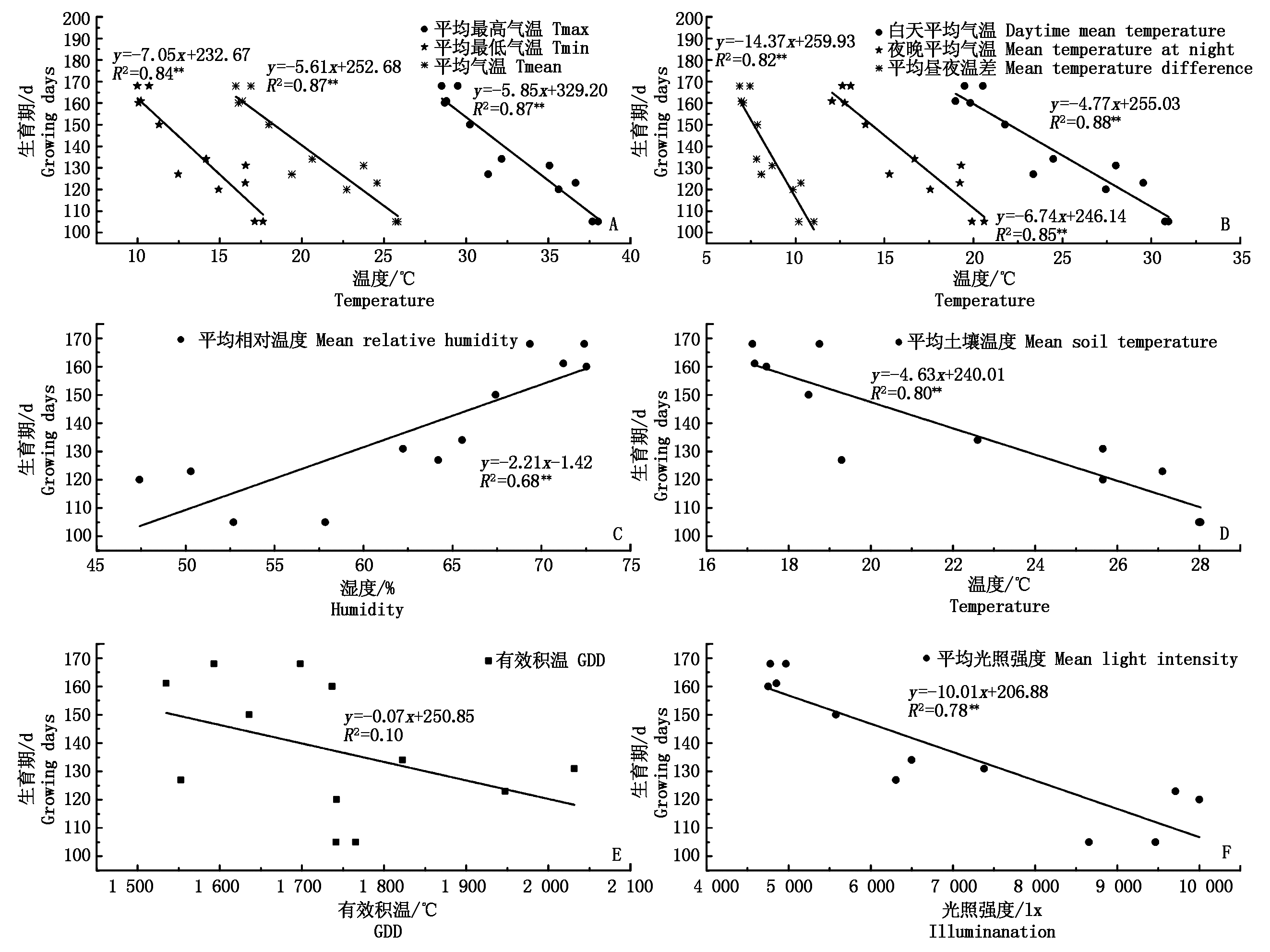
图1 番茄生育期与环境因子的相关性分析
Fig.1 Correlation analysis of environment factors and growing days
2.4 不同处理对番茄产量的影响
从表3看出,各定植期的番茄的产量、单株结果数和单果质量均存在显著差异。产量最高的定植期是2018年1月27日,其次是2017年12月27日和2017年2月27日,最低的是2017年6月27日,其次是2017年7月27日,且2017年6月27日和2017年7月27日定植的番茄产量仅为2018年1月27日定植的番茄产量的19.83%和20.28%。2018年1月27日和2017年12月27日定植的番茄单株结果数显著高于其他处理,而2017年6月27日和2017年7月27日定植的番茄单株结果数显著低于其他处理,且分别为2017年12月27日定植的番茄单株结果数的28.31%和26.96%。2017年2月27日和2018年1月27日定植的番茄单果质量显著高于其他处理,分别为144.60,135.59 g,2017年10月27日和2017年11月27日定植的番茄单果质量显著低于其他处理,且仅为2017年2月27日定植番茄单果质量的55.60%,56.00%。
2.5 不同处理番茄生育期环境因子与产量的相关性分析
表4为番茄产量与环境因子的相关性,包括平均最高气温、平均最低气温、平均气温、有效积温、白天平均气温、夜晚平均气温、平均昼夜温差、平均相对湿度、平均光照强度和平均土壤温度。结果表明,番茄各生育期的环境因子之间有显著的相关性。从全生育期相关系数来看,环境因子与番茄产量相关性不显著。 定植-开花期影响产量最显著的负因子是平均最低气温和平均气温,相关系数均为-0.76,即平均最低气温和平均气温越高,产量就越低。其次是夜晚平均气温。开花-采收期的环境因子与番茄产量无显著相关性。采收-拉秧期的平均相对湿度与产量呈显著的负相关,且相关系数为-0.88,而平均昼夜温差、平均光照强度、平均最高气温、平均气温与产量呈显著的正相关,其中平均昼夜温差与产量的相关系数最大为0.90,其次是平均光照强度,相关系数为0.81,说明增加该时期的昼夜温差和光照强度,有利于番茄产量的形成。
表3 不同处理对番茄产量的影响
Tab.3 Tomato yield in different treatment
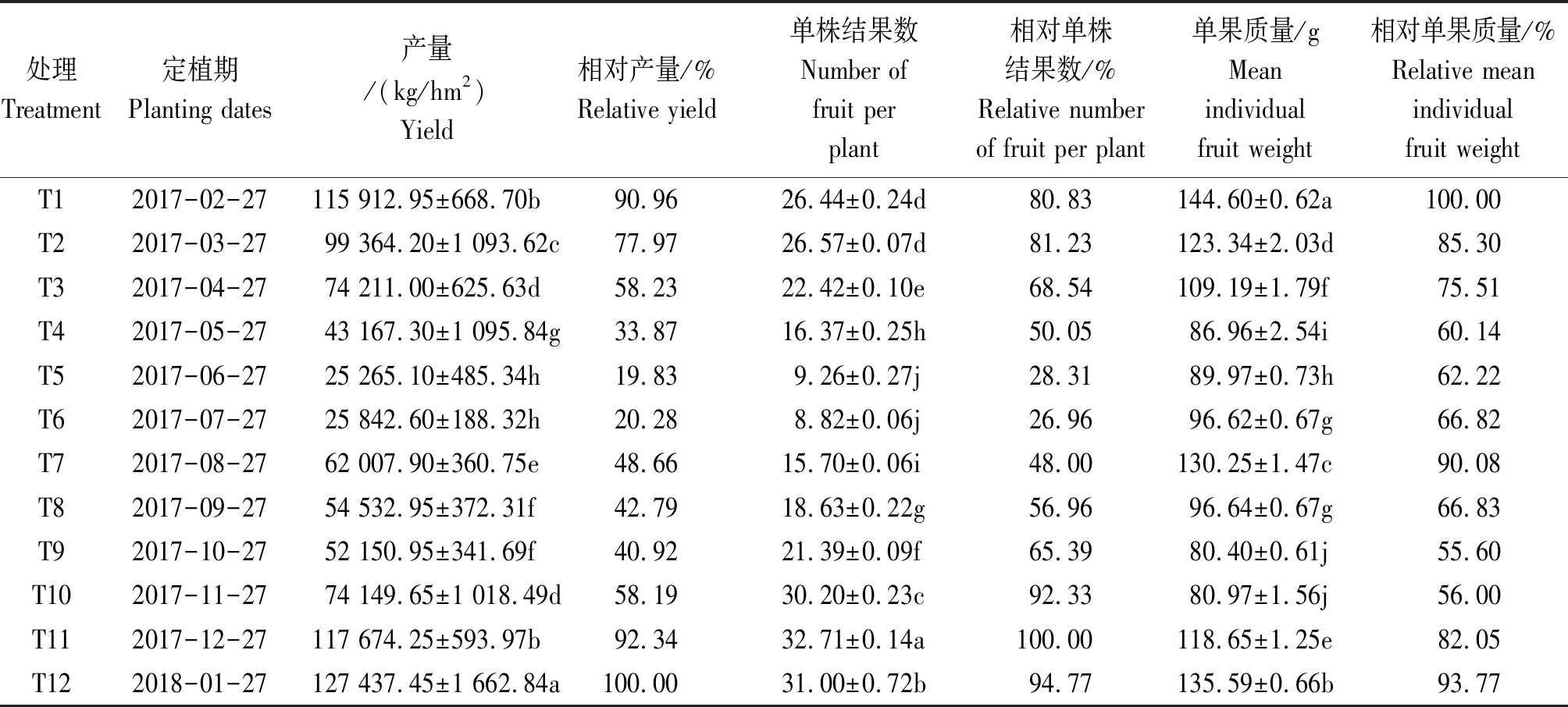
处理Treatment定植期Planting dates产量/(kg/hm2)Yield相对产量/%Relative yield 单株结果数Number of fruit per plant相对单株结果数/%Relative number of fruit per plant单果质量/gMean individual fruit weight相对单果质量/%Relative mean individual fruit weightT12017-02-27115 912.95±668.70b90.9626.44±0.24d80.83144.60±0.62a100.00T22017-03-2799 364.20±1 093.62c77.9726.57±0.07d81.23123.34±2.03d85.30T32017-04-2774 211.00±625.63d58.2322.42±0.10e68.54109.19±1.79f75.51T42017-05-2743 167.30±1 095.84g33.8716.37±0.25h50.0586.96±2.54i60.14T52017-06-2725 265.10±485.34h19.839.26±0.27j28.3189.97±0.73h62.22T62017-07-2725 842.60±188.32h20.288.82±0.06j26.9696.62±0.67g66.82T72017-08-2762 007.90±360.75e48.6615.70±0.06i48.00130.25±1.47c90.08T82017-09-2754 532.95±372.31f42.7918.63±0.22g56.9696.64±0.67g66.83T92017-10-2752 150.95±341.69f40.9221.39±0.09f65.3980.40±0.61j55.60T102017-11-2774 149.65±1 018.49d58.1930.20±0.23c92.3380.97±1.56j56.00T112017-12-27117 674.25±593.97b92.3432.71±0.14a100.00118.65±1.25e82.05T122018-01-27127 437.45±1 662.84a100.0031.00±0.72b94.77135.59±0.66b93.77
表4 番茄产量与环境因子的相关性分析
Tab.4 Correlation analysis of environment factors and tomato yield
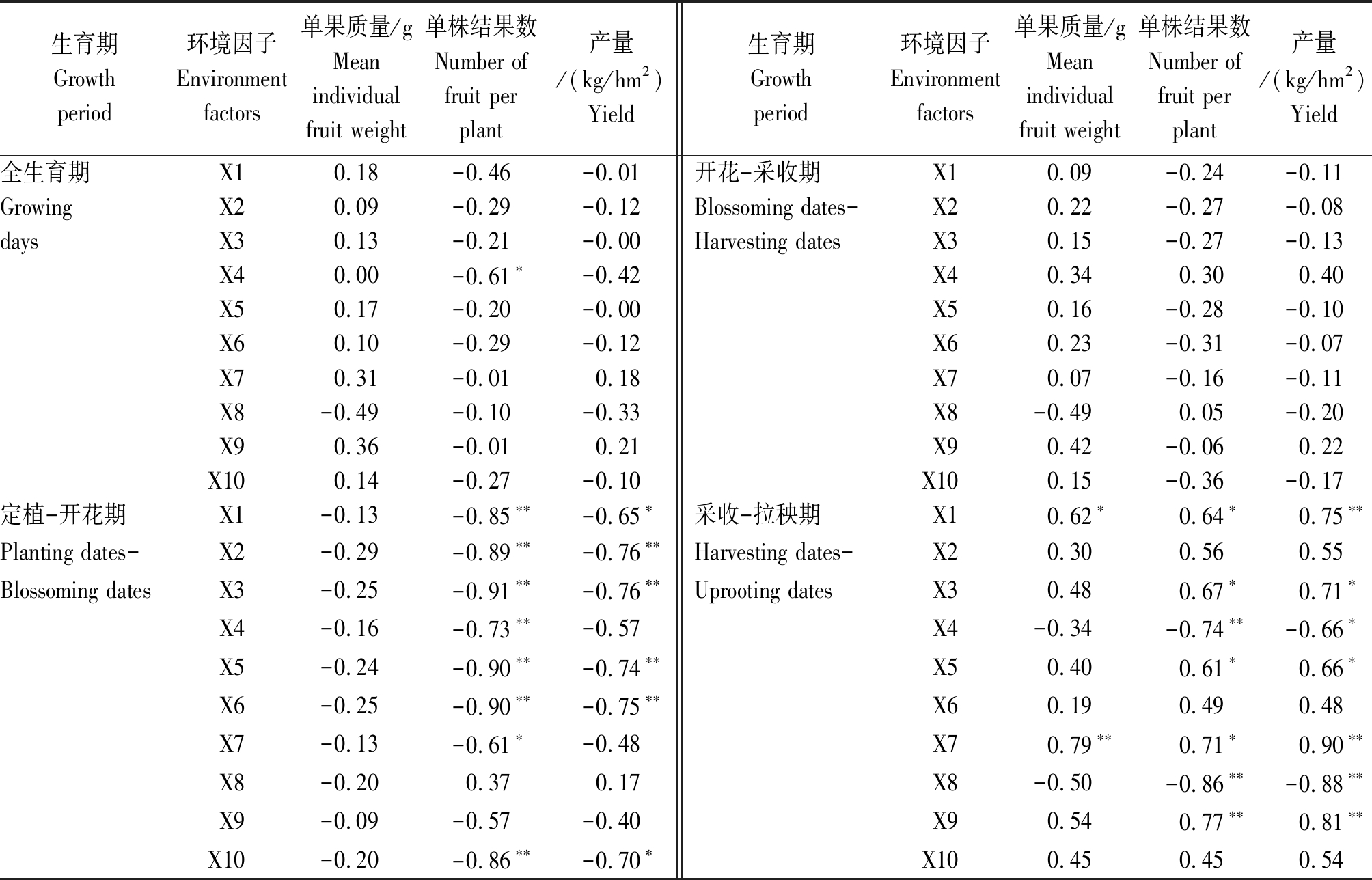
生育期Growth period环境因子Environment factors单果质量/gMean individual fruit weight单株结果数Number of fruit per plant产量/(kg/hm2)Yield生育期Growth period环境因子Environment factors单果质量/gMean individual fruit weight单株结果数Number of fruit per plant产量/(kg/hm2)Yield全生育期X10.18-0.46-0.01开花-采收期X10.09-0.24-0.11GrowingX20.09-0.29-0.12Blossoming dates-X20.22-0.27-0.08 daysX30.13-0.21-0.00 Harvesting datesX30.15-0.27-0.13X40.00-0.61∗-0.42X40.340.300.40X50.17-0.20-0.00X50.16-0.28-0.10X60.10-0.29-0.12X60.23-0.31-0.07X70.31-0.010.18X70.07-0.16-0.11X8-0.49-0.10-0.33X8-0.490.05-0.20X90.36-0.010.21X90.42-0.060.22X100.14-0.27-0.10X100.15-0.36-0.17定植-开花期X1-0.13-0.85∗∗-0.65∗采收-拉秧期X10.62∗0.64∗0.75∗∗Planting dates-X2-0.29-0.89∗∗-0.76∗∗Harvesting dates-X20.300.560.55Blossoming datesX3-0.25-0.91∗∗-0.76∗∗ Uprooting datesX30.480.67∗0.71∗X4-0.16-0.73∗∗-0.57X4-0.34-0.74∗∗-0.66∗X5-0.24-0.90∗∗-0.74∗∗X50.400.61∗0.66∗X6-0.25-0.90∗∗-0.75∗∗X60.190.490.48X7-0.13-0.61∗-0.48X70.79∗∗0.71∗0.90∗∗X8-0.200.370.17X8-0.50-0.86∗∗-0.88∗∗X9-0.09-0.57-0.40X90.540.77∗∗0.81∗∗X10-0.20-0.86∗∗-0.70∗X100.450.450.54
注:X1.平均最高气温;X2.平均最低气温;X3.平均气温;X4.有效积温;X5.白天平均气温;X6.夜晚平均气温;X7.平均昼夜温差;X8.平均相对湿度;X9.平均光照强度;X10.平均土壤温度。
Note: X1.Mean maximum temperature; X2.Mean minimum temperature; X3.Mean temperature;X4.GDD;X5.Daytime mean temperature;X6.Mean temperature at night;X7.Mean temperature difference; X8.Mean relative humidity; X9.Mean light intensity;X10.Mean soil temperature.
3 讨论与结论
温度是影响生育期的关键环境因子,并与其他环境因子相互影响,相互制约。徐富贤等[22]指出,营养生长期的温度越高,营养生长期越短,穗粒数显著降低。陈彦虎等[23]认为,平均温度越高,果实生长期就越短,这可能是因为高温停止了花蕾的分化,促使果实生长加速,营养生长期和生殖生长期缩短。赵玉萍等[24]通过研究不同温度对温室番茄生长发育及产量的影响得出,温度越高,番茄果实前期发育越快,成熟期越提前,这都与本研究结果一致。不同之处在于本研究还得出,平均光照强度和平均相对湿度也显著影响番茄的生育期长度。
关于环境因子对番茄产量的研究很多,但大多都集中在单一的环境因子[25-28]。本试验研究了多环境因子对番茄产量的影响,通过各环境因子之间及各环境因子与番茄产量、单果质量和单株结果数的相关分析得出,各环境因子之间存在高度的相互依赖性。武利明等[29]研究表明, 温度只有与其他的环境因子共同作用才能更好调控植株的生长发育。据张福墁[30]研究表明,番茄生长的最适温度为26 ℃,在30~35 ℃番茄生长发育会受到抑制作用。在本次试验中,2017年6月27日和2017年7月27日定植期,定植-开花期的平均温度分别为27.41,27.00 ℃,平均最高温度为38.82,39.33 ℃,远远超过了番茄生长的最适温度26 ℃,造成了2017年6月27日和2017年7月27日定植的番茄死苗现象,使定植-开花期缩短,严重影响番茄的产量。宋胭脂等[31]指出产量与温度呈显著至极显著的正相关,产量与光照呈正相关,产量与湿度呈负相关。这与本次试验中采收-拉秧期环境因子对番茄产量的影响一致。本试验还得出定植-开花期的产量与温度呈显著的负相关,这可能是因为前人没有分开分析不同生育期环境因子对番茄产量的影响。缪旻珉[32]研究表明,假如长期生长在高温下前期生长会徒长、根系生长受阻、植株提早衰老等。
宁夏日光温室番茄1 a种植两茬,分别为春茬和秋茬,春茬日光温室内环境较秋茬更适宜番茄果实生长发育。2017年8月27日定植的番茄在秋茬番茄中产量最高,为62 007.90 kg/hm2,其次是2017年9月27日,为54 532.95 kg/hm2,仅为2018年1月27日定植番茄产量的48.66%和42.79%。2017年8月27日定植,定植-开花期的白天平均气温为27.19 ℃,而定植-开花期的白天平均气温与产量呈显著负相关,说明气温偏高,需要延长通风时间,降低日光温室内气温。采收-拉秧期的平均气温仅为17.08 ℃,平均光照强度为7 240 lx,采收-拉秧期的温度、平均光照强度与产量呈显著正相关,说明温度和光照强度偏低,需要保温,挂反光膜增加光照强度。 2018年1月27日定植的番茄产量最高,为127 437.45 kg/hm2,其次为2017年12月27日和2017年2月27日,分别为117 674.25,115 912.95 kg/hm2。其中定植-开花期的平均温度为14.22,12.95,18.36 ℃,采收-拉秧期的昼夜温差为10.44,9.43, 10.47 ℃,定植-开花期、开花-采收期温度适宜,有利于番茄产量的形成。
本研究通过各生育期的环境因子与产量的相关性分析得出, 温度是番茄产量形成的关键环境因子。通过每茬试验的生育期及产量的对比得出,春茬番茄的最佳定植期是12月下旬-2月上旬,该时期内环境因子有利于番茄产量的形成。秋茬番茄的最佳定植期是8月下旬-9月上旬,该生育期内,可通过降低定植-开花期的气温,增加采收-拉秧期的温度和光照强度,从而提高番茄的产量。
[1] Pathak T B, Stoddard C S. Climate change effects on the processing tomato growing season in California using growing degree day model[J]. Modeling Earth Systems & Environment, 2018,4(2): 765-775. doi:10.1007/s40808-018-0460-y.
[2] 丁兆堂, 卢育华, 徐坤. 环境因子对番茄光合特性的影响[J]. 山东农业大学学报(自然科学版), 2003, 34(3): 356-360.
Ding Z T, Lu Y H, Xu K. Effect of environment factors on the photosynthetic characteristics of tomatoes[J]. Journal of Shandong Agricultural University(Natural Science), 2003, 34(3): 356-360.
[3] 杨再强, 朱凯, 彭晓丹, 赵翔, 王学林, 孙擎. 昼夜温差对设施番茄叶片光合特性和叶绿素荧光参数的影响[J]. 生态学杂志, 2013, 32(12): 3190-3196.
doi:10.13292/j.1000-4890.2013.0489.
Yang Z Q, Zhu K, Peng X D, Zhao X. Wang X L, Sun Q. Effects of day and night temperature difference on photosynthetic characteristics and chlo-rophyll fluorescence parameters of greenhouse tomato[J].Chinese Journal of Ecology, 2013, 32(12): 3190-3196.
[4] 袁小康, 杨再强. 昼夜温差对番茄果实品质动态变化的影响及模拟[J]. 中国农业气象, 2017, 38(6): 353-360. doi:10.3969/j.issn.1000-6362.2017.06.003.
Yuan X K, Yang Z Q. Effect of day and night temperature difference on fruit quality of tomato and its simulation models [J]. Chinese Journal of Agrometeorology, 2017, 38(6): 353-360.
[5] 李莉, 李佳, 高青, 陈金星. 昼夜温差对番茄生长发育、产量及果实品质的影响[J]. 应用生态学报, 2015, 26(9): 2700-2706. doi:10.13287/j.1001-9332.20150630.019.
Li L, Li J, Gao Q, Chen J X. Effects of day and night temperature difference on growth, development, yield and fruit quality of tomatoes[J].Chinese Journal of Applied Ecology,2015, 26(9): 2700-2706.
[6] 李煜姗. 昼夜温差对番茄根系分泌有机酸及养分吸收的影响[D]. 南京:南京信息工程大学, 2017.
Li Y S. Effect of difference between day and night temperature on jow molecular weight organ acid secretion nutrition uptake[D]. Nanjing:Nanjing University of Information Science and Technology, 2017.
[7] 廉华. 蔬菜产量形成与设施内环境因素之间的动态关系的研究[D].哈尔滨:东北农业大学,2001.
Lian H. Studies on the dynamic relations between vegetable yield formation and environmental factors in the facilities[D]. Harbin: Northeast Agricultural University, 2001.
[8] 齐国亮, 苏雪玲, 郑国琦, 杨涓, 包晗, 王俊. 气象因子对宁夏枸杞果实生长及多糖含量的影响[J]. 植物学报, 2016, 51(3): 311-321. doi: 10.11983/CBB15041.
Qi G L, Su X L, Zheng G Q, Yang J, Bao H, Wang J. Effects of Meteorological factor on fruit growth and Accumulation of Polysaccharides in Lycium Barbarum L. [J]. Chinese Bulletin of Botany, 2016, 51(3): 311-321.
[9] 高尚, 明博, 李璐璐, 谢瑞芝, 薛军, 侯鹏, 王克如, 李少昆. 黄淮海夏玉米籽粒脱水与气象因子的关系[J]. 作物学报, 2018, 44(12): 1755-1763.doi: 10.3724/SP.J.1006.2018.01755.
Gao S, Ming B, Li L L, Xie R Z, Xue J, Hou P, Wang K R, Li S K. Relationship between grain dehydration and meteorological factors in the Yellow-Huai-Hai Rivers summer maize[J]. Acta Agronomica Sinica, 2018, 44(12):1755-1763.
[10] 陈燕丽, 冯利平, 丁美花, 莫伟华, 匡昭敏. 气象因子对广西新植蔗和宿根蔗茎伸长的影响[J]. 作物学报, 2016, 42(4): 583-590. doi: 10.3724/SP.J.1006.2016.00583.
Chen Y L, Feng L P, Ding M H, Mo W H, Kuang Z M. Effects of meteorological factors on stalk elongation in New-planting and Ra-tooning sugarcane[J]. Acta Agronomica Sinica, 2016, 42(4): 583-590.
[11] 陶炼, 杨文渊, 谢红江, 潘翠萍, 李艳峰, 李菊, 宦云敏. 西藏不同生态型区苹果品质评价及其对气象因子的响应[J]. 植物科学学报, 2018, 36(1): 86-93. doi: 10.11913/PSJ.2095-0837.2018.10086.
Tao L, Yang W Y, Xie H J, Pan C P, Li Y F, Li J, Huan Y M. Quality evaluation of ‘Golden Delicious’apple from different ecological regions in Tibet and its response to meteorological factors[J]. Plant Science Journal, 2018, 36(1): 86-93.
[12] 赵玉萍, 邹志荣, 杨振超, 胡晓辉, 白鹏威, 李鹏飞, 任雷. 不同温度和光照对温室番茄光合作用及果实品质的影响[J]. 西北农林科技大学学报(自然科学版), 2010, 38(5): 125-130. doi:10.13207/j.cnki.jnwafu.2010.05.025.
Zhao Y P, Zhou Z Y, Yang Z C, Hu X H, Bai P W, Li P F, Ren L. Effect of temperature and light to tomato photosynthesis and quality in greenhouse[J]. Journal of Northwest A&F University(Natural Science Edition), 2010, 38(5): 125-130.
[13] 程智慧, 陈学进, 赖琳玲, 滕林. 设施番茄果实生长与环境因子的关系[J]. 生态学报,2011, 31(3): 742-748.
Chen Z H, Chen X J, Lai L L, Teng L. Relationship between tomato fruit growth and environmental factors under protected facility cultivation[J]. Acta Ecologica Sinica,2011, 31(3): 742-748.
[14] 王强, 宋羽, 帕提古丽,杨生保, 杨涛, 王柏柯, 王浩, 余庆辉. 不同天气条件下温室番茄栽培环境因子的变化特征研究[J]. 新疆农业科学, 2013,50(1): 84-88. doi:10.6048/j.issn.1001-4330.2013.01.014.
Wang Q, Song Y, Patiguli,Yang S B, Yang T, Wang B K, Wang H, Yu Q H. The study on variation characteristics of environmental factors in tomato greenhouse cultivation under different weather conditions[J]. Xinjiang Agricultural Sciences, 2013,50(1): 84-88.
[15] Feyzbakhsh M T, Kamkar B, Mokhtarpour H, Asadi M E.Effect of soil water management and different sowing dates on maize yield and water use efficiency under drip irrigation system[J]. Archives of Agronomy and Soil Science, 2015, 61(11):1581-1592. doi:10.1080/03650340.2015.1019345.
[16] Silva R R, Benin G, De Almeida J L,Fonseca I C D ,Zucareli C. Grain yield and baking quality of wheat under different sowing dates[J]. Acta Scientiarum-agronomy, 2014, 36(2): 201-210. doi:10.4025/actasciagron.v36i2.16180.
[17] Deguchi T, Iwama K, Matsumoto M, Tanigawa J. Effect of varietal difference in root system on hydraulic conductance in potatoes under different soil water conditions and planting dates[J]. Potato Research, 2015, 58(2):103-119. doi: 10.1007/s11540-015-9289-1.
[18] Tang J Z, Wang J, Wang E L, Yu Q, Yin H, He D, Pan X B. Identifying key meteorological factors to yield variation of potato and the optimal planting date in the agro-pastoral ecotone in North China[J]. Agricultural & Forest Meteorology, 2018, 256-257(15): 283-291.doi: 10.1016/j.agrformet.2018.03.022.
[19] Sorensen I, Stone P, Rogers B. Effect of sowing time on yield of a short and a long season maize hybrid[J]. Agronomy New Zealand, 2000,30:63-66.
[20] Khan A, Wang L S, Ali S, Tung S A, Hafeez A, Yang G Z. Optimal planting density and sowing date can improve cotton yield by maintaining reproductive organ biomass and enhancing potassium uptake[J]. Field Crops Research, 2017, 214:164-174. doi:10.1016/j.fcr.2017.09.016.
[21] Liu Y J, Qin Y, Ge Q S, Dai J H, Chen Q M. Reponses and sensitivities of maize phenology to climate change from 1981 to 2009 in Henan Province, China[J]. Journal of Geographical Sciences, 2017, 27(9): 1072-1084.
[22] 徐富贤, 周兴兵, 张林, 蒋鹏, 刘茂, 朱永川, 郭晓艺, 熊洪. 四川盆地东南部气象因子对杂交中稻产量的影响[J]. 作物学报, 2018, 44(4): 601-613.
doi: 10.3724/SP.J.1006.2018.00601.
Xu F X, Zhou X B, Zhang L, Jiang P, Liu M, Zhu Y C, Guo X Y, Xiong H. Effects of climatic factors in the southeast of Sichuan Basin on frain yield of Mid-season hybrid rice[J]. Acta Agronomica Sinica, 2018, 44(4): 601-613.
[23] 陈彦虎, 顾宁, 刘静, 金伟平. 宁夏石嘴山市枸杞产量与气象条件的关系[J]. 安徽农业科学, 2012, 40(27): 13508-13511. doi:10.13989/j.cnki.0517-6611.2012.27.115.
Chen Y H, Gu N,Liu J, Jin W P. Relationship between Lycium barbarum L.yield and its meteorological conditions in Shizuishan city of Ningxia Province[J]. Journal of Anhui Agricultural Sciences, 2012, 40(27): 13508-13511.
[24] 赵玉萍, 邹志荣, 白鹏威, 任雷, 李鹏飞. 不同温度对温室番茄生长发育及产量的影响[J]. 西北农业学报, 2010, 19(2): 133-137.doi:10.3969/j.issn.1004-1389.2010.02.027.
Zhao Y P, Zhou Z Y, Bai P W, Ren L, Li P F. Effect of different temperature on the growth and yield of tomato in greenhouse[J]. Acta Agriculturae Boreali-occidentalis Sinica,2010, 19(2): 133-137.
[25] 朱雨晴, 薛晓萍. 遮阴及复光对花果期番茄叶片光合特性的影响[J]. 中国农业气象, 2019,40(2): 126-134. doi:10.3969/j.issn.1000-6362.2019.02.007.
Zhu Y Q, Xue X P. Effects of shading and light restoration on photosynthetic characteristics of tomato leaves during flowering and fruit period[J]. Chinese Journal of Agrometeorology, 2019,40(2): 126-134.
[26] 刘汉文, 武国慧, 王玲莉, 张蕾, 高纪超, 丁芳, 张雷, 段刚强, 李杰, 王丽希, 石元亮.不同浓度CO2与化肥配施对番茄生长和养分吸收的影响[J]. 中国土壤与肥料, 2018(6): 118-125. doi: 10. 11838/ sfsc.20180617.
Liu H W, Wu G H, Wang L L, Zhang L, Gao J C, Ding F, Zhang L, Duan G Q, Li J, Wang L X, Shi Y L. Effects of different concentrations of CO2 and inorganic fertilizer application on the growth and nutrient utilization of tomato[J]. Chinese Soil and Fertilizer, 2018(6): 118-125.
[27] 裴红霞, 崔静英, 赵云霞, 高晶霞, 冯海萍, 杨冬艳, 谢华. 不同土壤水分下限对沙培番茄生长发育及前期水分利用率的影响[J]. 甘肃农业大学学报, 2017, 52(6): 39-43. doi:10.13432/j.cnki.jgsau.2017.06.007.
Pei H X, Cui J Y, Zhao Y X, Gao J X, Feng H P, Yang D Y, Xie H. Effects of irrigation threshold on the growth and early water use efficiency of tomato on aeolian sandy land[J]. Journal of Gansu Agricultural University, 2017, 52(6): 39-43.
[28] 林婧. LED补光对樱桃番茄生长发育、产量及品质的影响[D].邯郸:河北工程大学, 2018.
Lin J. The influence of LED lights on the growth, yield and quality of cherry tomato[D]. Handan:Hebei University of Engineering, 2018.
[29] 武利明, 张喜春, 肖光辉. 环境因子对番茄生长发育的影响[J].中国农学通报, 2014, 30(13): 214-219. doi:10.3969/j.issn.1009-4229.2015.02.017.
Wu L M, Zhang X C, Xiao G H. Effects of environmental factors on tomato growth[J]. Chinese Agricultural Science Bulletin, 2014, 30(13): 214-219.
[30] 张福墁. 温度与温室蔬菜栽培[J]. 农业工程技术:温室园艺, 1995(8): 11-12.
Zhang F M. Temperature and greenhouse vegetable cultivation[J].Agricultural Engineering Technology:Greenhouse Horticulture, 1995(8): 11-12.
[31] 宋胭脂, 张建平, 邢丰才, 何卫国, 刘永红, 宋海涛. 现代温室黄瓜产量规律及环境因子分析[J]. 西北农林科技大学学报(自然科学版), 2005, 33(2): 107-111. doi:10.3321/j.issn:1671-9387.2005.02.024.
Song Y Z, Zhang J P, Xing F C, He W G, Liu Y H, Song H T. An analysis of cucumber yield laws and environmental factors in modern greenhouse[J]. Journal of Northwest A&F University(Natural Science Edition), 2005, 33(2): 107-111.
[32] 缪旻珉. 黄瓜(Cucumis sativus L.)热伤害与热适应生理机制及耐热栽培技术研究[D]. 南京:南京农业大学, 2000.
Miu M M. Studies on the mechanism of heat injury and heat adaptation and summer cultivation technique of cucumber(Cucumis sativus L.)[D]. Nanjing:Nanjing Agricultural University,2000.